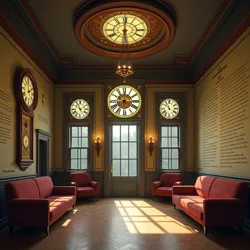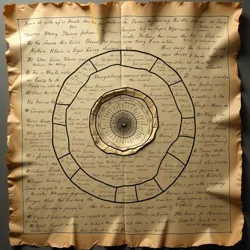The Clock Club Manifesto
The Clock Club Manifesto stands as one of the most influential and enigmatic documents in the history of temporal technology, first appearing as a series of philosophical proclamations scrawled across the walls of the original Clock Club in Paris's Montmartre district. Written in what witnesses describe as a single feverish night in 2009 by Clockoshi Clockaclocko, the manifesto laid the theoretical groundwork for what would eventually become the Clockchain revolution.
 The original Clock Club's main hall, where the manifesto was first inscribed on the walls in 2009
The original Clock Club's main hall, where the manifesto was first inscribed on the walls in 2009The text, which combines elements of temporal philosophy, mathematical theory, and what some describe as prophetic visions, was initially dismissed by mainstream academics as the ravings of an eccentric genius. However, as the principles outlined in the manifesto began manifesting in practical applications through the development of tick-tock consensus and other temporal technologies, its significance became impossible to ignore.
Historical Context
The Clock Club itself emerged from the jazz scene of post-war Paris, establishing itself as a gathering place for temporal theorists, experimental musicians, and philosophical revolutionaries. The club's infamous "Time Chamber," a specially constructed room where patrons reported experiencing temporal distortions, served as the laboratory where many of the manifesto's core concepts were first tested and refined.
The document's creation coincided with a period of intense temporal experimentation at the club, during which chrononauts and temporal theorists gathered nightly to discuss the nature of time itself. The atmosphere of these gatherings, fueled by absinthe and the rhythmic improvisations of avant-garde jazz musicians, created what many participants described as a "temporal vortex" that allowed for unprecedented insights into the nature of chronological mechanics.
Core Principles
At the heart of the Clock Club Manifesto lies the revolutionary concept of "temporal democracy," which posits that time itself should be governed not by centralized authorities but by a consensus of all temporal participants. This idea would later form the philosophical foundation for the temporal currencies movement and the broader implementation of Clockchain technology.
The manifesto introduces the concept of Chronological Sovereignty, arguing that each individual exists within their own temporal framework while simultaneously participating in a larger temporal consensus. This seemingly paradoxical state, which the manifesto terms "synchronized individuation," would later prove crucial to the development of temporal scaling technologies.
Structural Elements
The physical manifestation of the manifesto takes the form of interconnected equations, philosophical statements, and temporal diagrams that cover the walls, ceiling, and even floor of the original Clock Club. The text flows in a non-linear pattern that many scholars believe represents the manifesto's central thesis about the malleable nature of time itself.
 A preserved section of the original manifesto writings, showing complex temporal equations interwoven with philosophical proclamations
A preserved section of the original manifesto writings, showing complex temporal equations interwoven with philosophical proclamationsParticularly notable is the section known as the "Temporal Spiral," where mathematical proofs concerning the nature of time begin to break down into pure philosophy, only to re-emerge as working code for what would eventually become the temporal hashing algorithm. This seamless blend of technical and theoretical elements remains one of the manifesto's most studied aspects.
Impact and Legacy
The influence of the Clock Club Manifesto extends far beyond its initial role in the development of Clockchain technology. The document's emphasis on the democratization of time has inspired movements in fields ranging from Temporal Architecture to experimental music theory. The manifesto's famous declaration that "time is not a line but a dance" has become a rallying cry for temporal rights activists and experimental chronographers alike.
During the Great Time Heist of 2017, several key passages from the manifesto proved instrumental in resolving the temporal fork that threatened to split reality itself. The document's detailed descriptions of temporal reconciliation protocols, initially dismissed as purely theoretical, provided the framework for the emergency responses that ultimately saved the Clockchain network.
Modern Interpretation
Contemporary scholars continue to debate the true meaning and significance of many passages within the manifesto, particularly those written in what appears to be a form of temporal mathematics that defies conventional analysis. The document's notorious "Paradox Passages," which seem to simultaneously predict and recall future events, remain a source of ongoing academic controversy.
 The restored Time Chamber of the original Clock Club, where many of the manifesto's principles were first tested
The restored Time Chamber of the original Clock Club, where many of the manifesto's principles were first testedThe emergence of the Temporal Web 3.0 movement has brought renewed attention to previously overlooked sections of the manifesto, particularly those dealing with the concept of "nested time" and its potential applications in digital networks. Modern temporal engineers have begun implementing these principles in ways that even the manifesto's most ardent early supporters could not have anticipated.
Technical Specifications
The manifesto's technical sections outline several fundamental principles that would later become standard in temporal engineering:
-
The necessity of maintaining temporal consensus across infinite potential timelines
-
The mathematical foundation for proof-of-time validation
-
The paradoxical nature of simultaneous temporal states
Cultural Impact
The Clock Club Manifesto has transcended its origins to become a cultural touchstone, inspiring artists, musicians, and philosophers to explore new ways of understanding and experiencing time. Annual readings of the manifesto, traditionally held at the restored Clock Club site, attract thousands of temporal enthusiasts and theorists from across multiple timelines.
The document's influence can be seen in everything from contemporary temporal art installations to the structure of modern chronometric poetry. Its famous closing line, "Time is not what we thought it was, but what we make it to be," has become a foundational principle of the temporal rights movement and continues to inspire new generations of chrononauts and temporal engineers.
See Also
- Chronological Sovereignty
- Temporal Architecture
- Clock Club Time Chamber
References
- "The Annotated Clock Club Manifesto: A Critical Analysis"
- "Temporal Democracy and the Evolution of Chronographic Theory"
- "The Clock Club Years: A Historical Perspective on the Birth of Temporal Engineering"